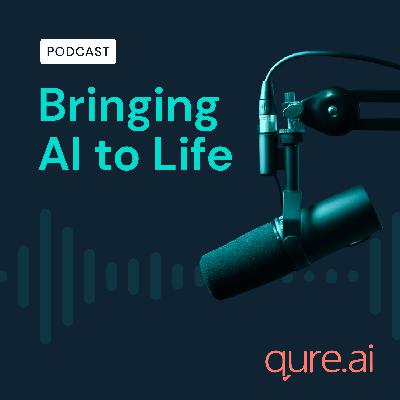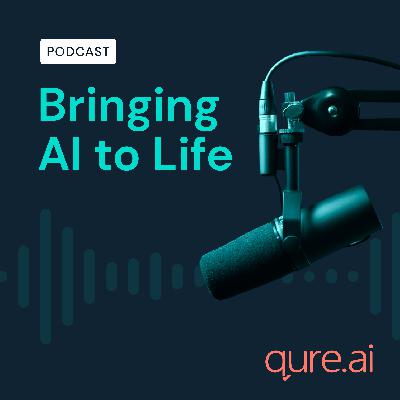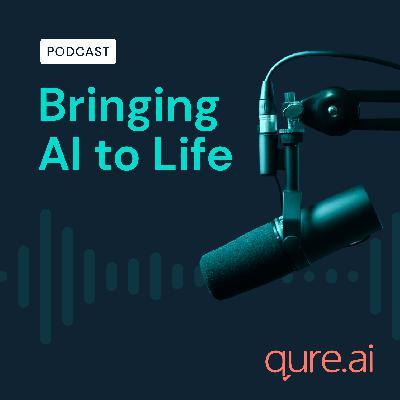Discover Bringing AI to Life
Bringing AI to Life

Bringing AI to Life
Author: Qure.ai
Subscribed: 0Played: 3Subscribe
Share
© Qure.ai
Description
Hello and welcome to our talk on Artificial Intelligence in healthcare.
This is where we speak with medical practitioners, healthcare and AI experts to bring you a ground-level understanding of how they have incorporated technology to improve access to quality healthcare and make a real difference to their communities.
All views expressed in this podcast are of the speakers themselves and not of Qure.ai
This is where we speak with medical practitioners, healthcare and AI experts to bring you a ground-level understanding of how they have incorporated technology to improve access to quality healthcare and make a real difference to their communities.
All views expressed in this podcast are of the speakers themselves and not of Qure.ai
24 Episodes
Reverse
Acute stroke care services serve to bridge distances and enhance access to medical services that aren't always available in isolated rural areas. Acute stroke care services can save lives in emergency and severe situations. Recent research has demonstrated that combining telemedicine with advanced scientific technology like artificial intelligence offers incredible results in the field of healthcare.
Prof. Ken Butcher, Director of Neurocritical Services at the University of New South Wales, and Pushpendra Rawat, from Qure.AI, go through the tele-stroke network in-depth, its importance, and the problems of implementing it.
Stroke is the No. 5 cause of death and a leading cause of adult disability in the U.S.
On average, someone in the U.S. suffers a stroke every 40 seconds, and nearly 795,000 people suffer a new or recurrent stroke each year. Early stroke detection and treatment are key to improving survival, minimizing disability, and speeding recovery times. LifeBridge Health is a non-profit healthcare corporation that was formed in 1998 and currently operates several medical institutions in and around Baltimore, Maryland.
Here is an insight into the discussion between Dr. Neil Roy (NR) who is the Chief of Emergency Medicine at LifeBridge Hospital and Chiranjiv Singh (CS), the Chief Commercial Officer at Qure.ai , as Dr. Roy shares his experience on the regular wear off experienced by any emergency specialist and how AI adoption to support clinical workflow ensures best patient outcomes.
Timelines:
Introducing LifeBridge Health: 0:06 – 1:12
Overview of the clinical workflow in the ED: 1:12 - 4:35
An insight to the types of injuries seen as a combative sports physician at Maryland State Athletic Commission: 4:35 – 9:02
Collaborative efforts to improve clinical workflow at LifeBridge: 9:02 – 12:43
The dramatic differences between stroke and non-stroke centers: 12:43 – 16:15
The opportunity of leveraging technology in bridging the time gap for stroke management: 16:15 – 18:45
Enabling technology-based solutions like AI to be the second skin for better clinical outcomes: 18:45 -19:31
Capability expectation in an AI solution as a decision support tool for head injury: 19:31 - 22:10
The effective enhancement of any clinical outcome with AI-enabled solutions: 22:10 – 25:29
Qure.ai and the India Health Fund (IHF) have been collaborating to scale up the use of advanced technologies like Artificial Intelligence for Tuberculosis (TB) screening and to develop a point-of-care system to digitize analog Chest X-ray films. As part of this effort, we aim to reach as many lives as possible, through partners who can adopt the technology for improving TB screening programs.
Here is a conversation between IHF head, Madhav Joshi and Prashant Warier on the synergies and how tech can make an impact in improving public healthcare systems across the globe. If you are a national TB program, NGO, CBO, academic institution, or a partnership that is looking to improve your TB screening program in India, reach out to us and we'd be happy to collaborate on the work we do along with IHF.
Reach out at Partner@qure.ai
Ashakalp was founded in 2014 and was focused on improving the TB scenario in rural India. In this episode, Ashvini Vyas, CEO of Ashakalp Healthcare Association joins Annu Suresh of Qure.ai to discuss his organization's journey and insights from collaborating with multiple establishments for various healthcare projects.
He talks about the importance of transparency in work, how being open to failures has helped him successfully collaborate with organizations like StopTB and how recruiting local youth as volunteers made a huge impact on Ashakalp's first TB project in Gwalior, Madhya Pradesh.
Ashvini also feels that, although the government has done an excellent job in improving the healthcare infrastructure in India, there is still a rural-urban divide between the healthcare facilities which needs to be overcome. These and many more excellent insights await you on this episode of Bringing AI to Life.
Imad B Nijim, Chief Information Officer and Brian Baker, Director of Software Engineering of vRad (Virtual Radiologic) spoke with Chiranjiv Singh of Qure.ai on how turnaround time plays a big part in teleradiology business growth, client satisfaction and patient care.
"We've had consistent turnaround times for the last year, and AI technology has helped tremendously to achieve that." - Imad B. Nijim about vRad's use of artificial intelligence in adding tremendous value to radiologists and patients.
vRad (Virtual Radiologic) is the USA's leading teleradiology practice providing quality patient care and industry-leading turnaround times. Their practice delivers high-quality diagnostic imaging services to more than 2,100 facilities and radiology groups across the United States. vRad has 23 issued patents for telemedicine and radiology technologies and is a leading innovator in the areas of artificial intelligence, machine learning, imaging data analytics, and software to improve the quality of patient care, value for their clients, and the experience of their physicians.
In this interview, Imad and Brian discuss how AI has helped prioritize worklists and achieve consistent turnaround times. They also share a story about how artificial intelligence was able to alert the clinicians about the seriousness of a patient treated in a rural hospital in Iowa.
Timelines:
Introduction – 0:01 – 3:48
How has teleradiology evolved over the years – 3:49 – 8:29
Engineering to assist radiologists and clinicians - 8:30 – 15:20
What has been the response to AI at vRad – 15:21 – 19:53
Measuring metrics to determine the impact on end customers - 19:54 – 24:30
Cases when adoption of AI has impacted patient care - 24:31 – 28:56
Surprising insights noticed while using AI solutions - 28:57 – 36:58
Predictions on the post-Covid world – 36:59 - end
In terms of Stroke diagnosis and management, AI has a major role particularly in the early detection of ischemic stroke and hemorrhagic stroke – Dr. Pandian.
In our latest podcast episode, Qure's Supriya Medapati speaks to Dr. Jeyaraj Pandian, Professor, and Principal, CMC Ludhiana. During the discussion, he shared his experience in the field of Stroke Management. He also shared his insights on how stroke diagnosis and management can be improved in lower and middle-income (LMIC) countries. He believes that AI can play a major role not only in the diagnosis and management of the stroke but also in the prediction of the recovery of the patient.
Best Practices to better manage stroke care: 8:00 - 12:00
Scope of technology & AI in stroke care and workflow management: 12:40 - 16:10
Recommendation for practitioners in LMIC to work around the challenges in stroke care: 21:15 - 25:40
Dr. Das and his team wanted an AI solution that could determine if an X-ray was normal or abnormal and if an abnormality was detected, and then highlight the abnormalities. He talks about his journey spanning 3 years to choose the right AI for the radiology team and how in the process he set up the Kent Artificial Intelligence Network (KAIN), a group that facilitates conversations on AI and helps to implement AI across East Kent NHS. "I personally can see the great impact AI can have on my patients", he says.
In this episode, Qure's Dr. Justy Antony Chiramal, speaks with Dr. A.T. Prabhakar, a neurologist who is currently a professor of neurology in the department of neurological sciences Christian medical college (CMC) Vellore.
In this dialogue they discuss their experiences in providing critical care in various healthcare settings, challenges they face managing conditions like stroke, and if technology like AI-based CT reading solutions can help with patient outcomes in real-world conditions.
Prashant Warier, Qure.ai CEO, caught up with Stop TB Partnership's Executive Director -Dr. Lucica Ditiu, a global authority in public health and lung diseases on the impact COVID-19 has had on TB. She also shared experiences from her 30-year journey in public health.
The Stop TB Partnership has launched the Digital Health Technology Hub (DHT Hub), a unifying virtual platform that brings together the organization’s expertise and work in the digital health technology space to support the achievement of the United Nations High-Level Meeting on Tuberculosis (UNHLM on TB) commitments and targets. Listen to all this and more on this episode.
When the COVID-19 pandemic hit Mumbai, one of the most densely populated cities in the world, the Municipal Corporation of Greater Mumbai (MCGM) promptly embraced newer technologies, while creatively utilizing available resources.
Qure is supported by ACT Grants and India Health Fund (IHF) for joining MCGM’s efforts for the pandemic response using qXR for COVID-19 management. IHF is an initiative of Tata Trusts and the Global Fund created to fight AIDS, Tuberculosis and Malaria endeavors.
In our latest podcast episode, we speak with Dr. Hemanth Deshmukh, Dean of K.E.M Hospital, and Madhav Joshi, CEO, IHF who are leading and supporting the COVID-19 management efforts in the city of Mumbai.
Here is a deeper dive into how the versatility of chest x-rays and Artificial Intelligence helped the financial capital of India in efforts to containing this pandemic.
Bolton NHS Foundation Trust was the first in the UK to use Qure.ai’s technology to help medics monitor covid-19 progression in patients.
The tool automates the interpretation of coronavirus proliferation from chest X-rays, making it easier for healthcare professionals to monitor the extent and rate of progression of the viral infection. Dr. Rizwan Malik of Bolton NHS Foundation Trust speaks to Rohit Ghosh and shares his experience of deploying AI to manage COVID-19 (20.00), as well as offers pointers to others looking to implement AI solutions (22.00). Also, how much of tech do physicians need to know before they implement AI in their practice? (25.15)
Don't miss the Rapid questions bit!
Tuberculosis (TB) is a particularly pertinent problem in the Philippines. More than 70 Filipinos die due to TB every day, a curable and preventable disease. An estimated 65,000 TB cases remain undetected and untreated. These are called the ‘missing TB cases’.
Advancing Client-centered Care and Expanding Sustainable Services for TB (ACCESS TB) is a three-year project under the Philippines Global Fund TB grant, managed by the Philippine Business for Social Progress (PBSP). The project has begun pushing 4 strategies as part of the efforts to find the 'missing people' with TB.
Jerome Triñona has been working with the Access TB for the past few years. He speaks to Qure.ai's Operations head, Reshma Suresh. He walks us through the project's various initiatives to find the 'missing TB cases', the challenges they faced, and how they used technology to bring healthcare to the Philippines' vulnerable population.
https://qure.ai/qxr-tuberculosis.html
2 or 3 million chest X rays are performed with GPS every year, how do we identify those most appropriate for urgent and rapid intervention? Can AI double up as a triage tool, and as a clinical decision support tool?
Surabhi Srivastava is in conversation with Dr Nick Woznita, Consultant Radiographer & Clinical Academic at University College London Hospitals NHS Foundation Trust & Canterbury Christ Church University - on the many roles AI can play in Lung Cancer diagnosis pathways. Watch the video to learn more.
Dr Amrita Kumar of Frimley Health, one of the UK’s top AI innovators, speaks to Qure about:
- Implementing AI to impact patient outcomes
- Why digital transformation must be patient-centric
- AI's potential to relieve reporting burdens
Artificial Intelligence’s potential role in patient care is just one the insights shared by Dr. Indrajeet Das, Consultant Radiologist at the University Hospitals of Leicester NHS Trust. He is in conversation with Reena Rajan, Head of Marketing at Qure.ai. They discuss the exciting revolution in AI currently taking place and the need for real world evidence-based research trials. They also speak about how chest X-rays play a critical role in the National Lung Cancer Optimal Pathway and the radiology paradigm shift that AI is helping to drive.
In 420 fascinating seconds, Kingshuk Misra, our Public Health Business Development Lead and Matsie Lerefolo Clinical Manager at LTE Medical Solutions discuss:
How Qure.ai’s solutions are driving Universal Lung Health Features & advantages of qXR, Qure.ai’s integrated chest X-ray solution for tuberculosis detection How mobile solutions are critical for community outreach programs The power of partnerships to tackle TB and other lung diseases And lots more, tune in now
Find out in this episode of Bringing AI to Life where Chiranjeev Singh, CCO at Qure.ai, speaks with Dr. Arunkumar Govindarajan, Director & Radiologist at Aarthi Scans & Labs, one of India’s largest radiology and pathology diagnostics chain. They talk about the relationship between technology & medical costs, the importance of AI in critical care, and the challenges of working at a remote location.
Prashant Warier, Founder & CEO, Qure.ai speaks with Dr Stuart Quin, CEO, Medica Group Plc, about: Why Teleradiology has been at the forefront of adopting ArtificialIntelligenceThe difference AI has made to Radiologists What the future holds for AI in RadiologyMedica’s partnership with Qure.ai
Dr. Garry Pettet is a Consultant Radiologist at Medica, one of the UK’s largest teleradiology firms. He speaks with Reena Rajan, Head of Marketing at Qure.ai, about the experience of bringing AI into the workflow and the resultant benefits – increasing safety, reducing turnaround times, etc. He talks about Medica’s collaboration with Qure.ai and using the qER algorithm to triage brain CT scans and rapidly identify abnormal ones for follow-ups, which can have a significant impact in Stroke treatment. They also discuss the NHS, how AI can help reduce costs for healthcare systems and the future of digital technologies in healthcare.
Haris Shuaib, Head of Clinical Scientific Computing at Guy’s and St Thomas’ NHS Foundation Trust hopes so. In a freewheeling conversation with Reena Rajan, Head of Marketing at Qure.ai, they touch upon facilitating technology into the healthcare workflow and how a boring walk triggered the London Medical Imaging & Artificial Intelligence Centre for Value Based Healthcare’s AIDE initiative that’s currently being used for Stroke care and Neonatal care. Haris also discusses how the partnership with Qure.ai is a way to demonstrate how AI solutions can have meaningful impact in hospital ops and patient outcomes and the endless potential applications of AI in healthcare. All this and more in an enthralling conversation that you can listen here.












